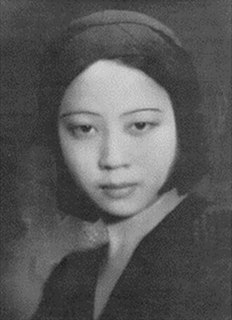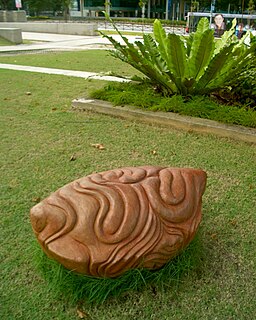Related Research Articles

Xu Beihong, also known as Ju Péon, was a Chinese painter.

Liu Kang was a Singaporean artist known for his Balinese-themed figurative paintings. He was a founding member of the Singapore Art Society, and was credited with developing the Nanyang Style, an art style associated with the Nanyang Academy of Fine Arts. He was also the father of the architect Liu Thai Ker.

Chen Chong Swee was a Singaporean watercolourist belonging to the pioneer generation of artists espousing the Nanyang-styled painting unique to Singapore, at the turn of the 20th century. He was also one of the first artists in Singapore to use Chinese ink painting techniques to render scenery and figurative paintings of local and Southeast Asian themes.

Chen Wen Hsi was a Chinese-born Singaporean artist, known for his avant-garde Chinese paintings.

Cheong Soo Pieng was a Singaporean artist who was a pioneer of the Nanyang art style, and a driving force to the development of Modernism in visual art in the early 20th-century Singapore. He was also known for his signature depiction of Southeast Asian indigenous tribal people with elongated limbs and torso, almond-shaped faces and eyes in his paintings.

Chua Ek Kay was a Singaporean artist hailed as the "bridge between Asian and Western art" with a unique painting style using Chinese ink on paper that demonstrated an ingenious blend of traditional Chinese painting forms with Western art theories and techniques. Most of his works were themed of Chinatown street scenes, lotuses, and abstract works inspired by Australian aboriginal cave paintings.

Lim Hak Tai, was one of Singapore's pioneer artist at the turn of the 20th century, and was the person who inspired the Nanyang School of art form, to reflect the 'Nanyang' region, both in painting style and subject matter.

Ng Eng Teng, The Grandfather of Singapore Sculpture was a sculptor in Singapore known for his figurative sculptures, many of which are found in public locations around Singapore. His legacy include the Mother And Child bronze sculpture outside Far East Shopping Centre along Orchard Road, and The Explorer located at the entrance of the Singapore Art Museum.

Georgette Liying Chendana Chen, most commonly known as Georgette Chen, was a Singaporean painter and one of the pioneers of modern Singaporean art as well as the Nanyang style of art in the region.

Mohammad Din Mohammad was a Singaporean Malay artist known for his works inspired by Sufism, with his artistic practice spanning painting, assemblage, and Islamic calligraphy. Mhd Din's works are also heavily influenced by his devotion to the practice of the Malay martial arts called silat. He was also a practising bomoh or traditional healer.

Han Sai Por is a Singaporean sculptor. A graduate of the Nanyang Academy of Fine Arts (NAFA), East Ham College of Art, Wolverhampton College of Art and Lincoln University, New Zealand, she worked as a teacher and later as a part-time lecturer at NAFA, the LASALLE-SIA College of the Arts, and the National Institute of Education, Nanyang Technological University, before becoming a full-time artist in 1997.

The Nanyang style of painting, also known as Nanyang art or the Nanyang school, was an art movement and tradition initially practised by migrant Chinese painters in Singapore from the late-1940s to 1960s. As immigrant artists taken by the novelty of tropical landscapes, the Nanyang artists' works characteristically depicted Southeast Asian subject matter such as tropical fruit, kampung scenes, and batik fabric while drawing upon a synthesis of Western watercolor and oil painting techniques with Chinese ink traditions.
Zhang Renxi, also known as Zhang Renxi (张仁熙), Jiaye (迦叶), Shengshi, and House of Flowing Water Sound Listening (听沨楼), was born in Quanzhou City, Fujian, China. He was a Chinese artist and poet, best known for his exquisite Chinese paintings of birds and flowers as well as fine seal carvings and calligraphy work.
Chng Seok Tin was a visually-impaired printmaker, sculptor and multi-media artist from Singapore. She was often inspired by the i-Ching and Buddhism. Her work has been shown internationally; Chng had over 26 solo shows and 100 group shows. In addition to her art, she was also a prolific writer and has published 11 collections of her writing, mostly in Chinese. She also advocated for artists with disabilities.

Chua Mia Tee is a Chinese-born Singaporean artist known for his social realist oil paintings capturing the social and political conditions of Singapore and Malaya in the 1950s and 60s. Chua was involved in the Equator Art Society, an artist group founded in 1956 whose social realist works sought to instil a distinct Malayan consciousness by representing the realities and struggles of the masses. For his contributions to the visual arts in Singapore, Chua was awarded the Cultural Medallion in 2015.
Thomas Yeo is a Singaporean artist. His first solo exhibition came in 1960 at the Singapore Chinese Chamber of Commerce and Industry. In 1984 he was awarded the Cultural Medallion.
Ho Kah Leong is a former Singaporean politician and was a member of the People's Action Party (PAP). He was the Member of Parliament (MP) for Jurong Single Member Constituency (SMC) from 1966 to 1997. After retirement from politics in December 1996, he became the principal of Nanyang Academy of Fine Arts (NAFA) from 1997 to 2003, and Executive director of NAFA International Pte Ltd from 2003 to 2005.
Ming Wong is a Singaporean contemporary artist who lives and works in Berlin, known for his re-interpretations of iconic films and performances from world cinema in his video installations, often featuring "miscastings" of himself in roles of varied identities.
Salleh Japar is a Singaporean contemporary artist working across sculpture, installation and painting, with his work coming into prominence in late 1980s Singapore. Within Singapore's history of contemporary art, Salleh is known for his collective work with Goh Ee Choo and S. Chandrasekaran for the seminal 1988 exhibition, Trimurti. In 2001, Salleh was one of four artists selected to represent at the very first Singapore Pavilion at the prestigious 49th Venice Biennale, alongside artists Henri Chen KeZhan, Suzann Victor, and Matthew Ngui.

The visual art of Singapore, or Singaporean art, refers to all forms of visual art in or associated with Singapore from its history to present. The history of Singaporean art includes the indigenous artistic traditions of the Malay Archipelago and the diverse visual practices of itinerant artists and migrants from China, the Indian subcontinent, and Europe. Singaporean art includes the sculptural, textile, and decorative art traditions of the Malay world; portraiture, landscapes, sculpture, printmaking, and natural history drawings from the country's colonial period; along with Nanyang style paintings, social realist art, abstract art, and photography practices emerging in the post-war period. Today, it includes the contemporary art practices of post-independence Singapore, such as performance art, conceptual art, installation art, video art, sound art, and new media art.
References
- ↑ Kua, Bak Lim (1999). 新华历史人物列传. 教育出版私营有限公司.
- 1 2 "Biographies of artists" (PDF). Nanyang Academy of Fine Arts . Retrieved 2 November 2022.
- ↑ "See Hiang To". Reference@NLB. Retrieved 2 November 2022.
- ↑ "文化界前辈施香沱逝世". Lianhe Wanbao . Singapore. 26 April 1990. Retrieved 2 November 2022.